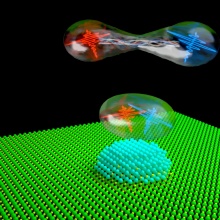A research team of the institute of semiconductor optics and functional interfaces (IHFG) of the University of Stuttgart experimentally verified the generation of polarization-entangled photon pairs in the emission wavelength range of the telecom C-band. The generation of entangled photons, i.e. a non-classical phenomenon which “bounds” the states of two different entities, is a cornerstone for the realization of quantum networks.
Quantum dots are one of the most prominent and promising candidates as non-classical light sources applied in quantum information technology. They have been proven to be able to emit single, indistinguishable and also polarization-entangled photon pairs via the biexciton-exciton cascade. All these properties have been demonstrated in the NIR regime (i.e. around 900 nm) and here, for the first time, the entangled photon emission was increased up to 1550 nm, key wavelength for fiber-based long-distance classical and quantum communication.
So far the best QD performances have been realized using InAs dots on GaAs platform (naturally emitting at NIR wavelength). This motivated the team of Prof. Dr. Peter Michler to push such a technology up to telecommunication wavelengths. After long efforts, in close collaboration with the epitaxy team led by Dr. Michael Jetter, it was possible to reach such a milestone, i.e. utilizing In(Ga)As dots to emit telecom-wavelength photons. The demonstrated entanglement generation in such a system foresees the possibility to extend the unique capabilities reached at NIR up to telecom wavelength. Emission in this regime represents a fundamental skill for fiber-based applications and additionally it is useful for satellite communication, since it marks an atmospheric transmission window.
After the verification of the single-photon nature of the harvested light, moreover an extraordinary low exciton fine-structure splitting (FSS) for most of the investigated quantum dots was measured: indeed, a large FSS inhibits the entanglement generation with high fidelity. Motivated by this observation, a set of polarization-resolved cross-correlation experiments was performed on an exemplary dot in order to reconstruct the two-photon polarization state that finally reveals the degree of entanglement.
Expert Contact:
Fabian Olbrich, University of Stuttgart, Institute of Semiconductor Optics and Functional Interfaces (IHFG), phone: +49 (0)711 685 65227, E-Mail
Originalpublikation:
Fabian Olbrich, Jonatan Höschele, Markus Müller, Jan Kettler, Simone Luca Portalupi, Matthias Paul, Michael Jetter, and Peter Michler, “Polarization-entangled photons from an InGaAs-based quantum dot emitting in the telecom C-band”, Applied Physics Letters 111, 133106 (2017), doi: http://dx.doi.org/10.1063/1.4994145


